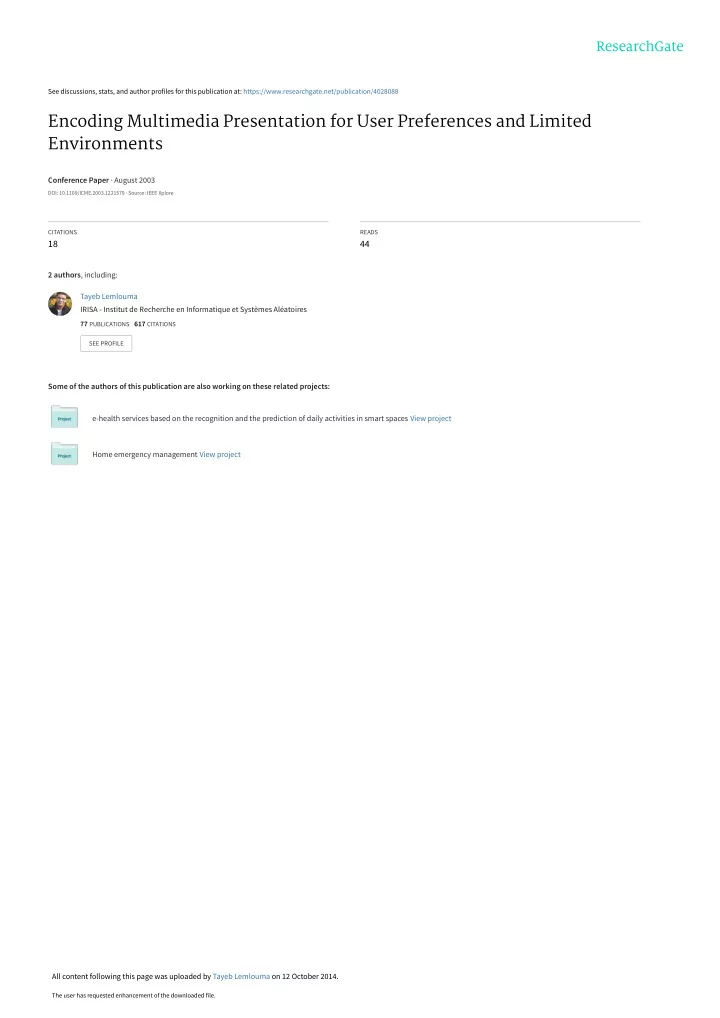

See discussions, stats, and author profiles for this publication at: https://www.researchgate.net/publication/4028088 Encoding Multimedia Presentation for User Preferences and Limited Environments Conference Paper · August 2003 DOI: 10.1109/ICME.2003.1221579 · Source: IEEE Xplore CITATIONS READS 18 44 2 authors , including: Tayeb Lemlouma IRISA - Institut de Recherche en Informatique et Systèmes Aléatoires 77 PUBLICATIONS 617 CITATIONS SEE PROFILE Some of the authors of this publication are also working on these related projects: e-health services based on the recognition and the prediction of daily activities in smart spaces View project Home emergency management View project All content following this page was uploaded by Tayeb Lemlouma on 12 October 2014. The user has requested enhancement of the downloaded file.
Author manuscript, published in "Proceedings of IEEE International Conference on Multimedia and Expo (ICME) (2003) 165-168" ENCODING MULTIMEDIA PRESENTATIONS FOR USER PREFERENCES AND LIMITED ENVIRONMENTS Tayeb Lemlouma and Nabil Layaïda OPERA Project, INRIA Rhône Alpes Research Unit Tayeb.Lemlouma@inrialpes.fr Nabil.Layaida@inrialpes.fr ABSTRACT The SMIL content control module [1] is used in order to generate a video presentation adapted to the user This paper discusses a new approach of generating TV-like preferences. The paper addresses also the problem of multimedia presentations that are adapted to the target user video content adaptation for limited devices. The preferences and to limited devices. Three main points are considered capability dimension is the memory of the discussed: 1) The encoding of video presentations from a SMIL target device. This dimension is chosen in order to avoid specification 2) The adaptation of the video content based on the the blocking of limited users when they access to rich user preferences, and 3) The delivery of adapted multimedia inria-00423422, version 1 - 9 Oct 2009 server multimedia presentations. presentations. The used architecture includes a content server, an adaptation proxy and a set of small devices in the form of 2. FROM SMIL TO VIDEO personal device assistants (PDA). These devices request the content through a wireless network. In order to show how the system behaves regarding the user preferences and capabilities, The video generation from the SMIL specification two negotiation dimensions are considered: the user language includes the SMIL parsing and the video encoding. and the memory capability of the device. The first dimension is SMIL specification used to generate a content that can be understood by the target user, e.g. a video with subtitles written in the preferred language. SMIL The second dimension is chosen to solve the problem of the Video output system blocking that usually happens when limited devices Video encoder access rich multimedia presentations over the network. Video input Figure 1: Video generation from the SMIL specification The video encoding entity (Figure 1) includes the decoding of the original video to an uncompressed form (RGB 24 bit format), the application of our SMIL encoder 1. INTRODUCTION and the generation of the output video. The used video decoder depends on which way the input video was Several multimedia presentation models exist; they encoded initially. The decoder is configured to generate consider not only the media content but also other an uncompressed form of each video frame which is dimensions of the presentation: logical, spatial, temporal simply the pixel representation of the video. Each pixel in and hyperlink. The declarative specification of the the RBG form is represented by three bytes that multimedia presentations really represents an important correspond to the red, green and blue color value of the advance in the multimedia handling field. This approach pixel. A line l of an original frame is represented by a set facilitates the manipulation and the processing of the of lineStride byte values. Where lineStride = pixelStride x presentation that has been considered as an atomic entity videoWidth . Here the pixelStride value equals to three (R, by classical approaches. G and B components). Since a frame is a set of SMIL 2.0 has become a World Wide Web Consortium videoHeight lines, the size of an uncompressed frame recommendation in 2001. It is the dominant representation equals to lineStride x videoHeigh bytes. in Web technology for describing timing and Since we discuss only TV-like multimedia synchronization of multimedia presentations. A careful presentations obtained after manipulating the original attention has been given, in the design of SMIL, to video; the SMIL encoder does not create pixels that are modularity and extensibility of the recommendation and not covered by the video frame box. This means formally three language profiles have been proposed [2]. In the that an encoded pixel p ( x , y ) created by the SMIL context of multimedia content adaptation for user encoder satisfies always the condition: 0 ≤ x ≤ videoWidth preferences, SMIL offers a set of interesting mechanisms and 0 ≤ y ≤ videoHeight . It is important to take into that provide a better flexibility [7]. In this paper we account this last assertion while authoring the SMIL exploit SMIL to ensure the encoding of the video content.
Recommend
More recommend